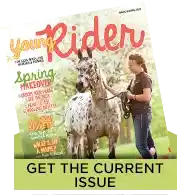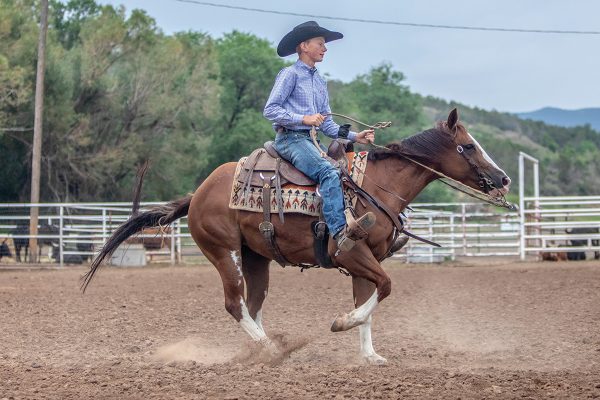
If you’ve watched a great reining pattern, you may be excited to get home and practice the moves on your own. A signature move of reining is the spin, where the horse quickly moves in a 360-degree turn, moving over his stationary inside hind leg.
In a spin, sometimes called a turnaround, the horse propels his outside hind leg and his front legs forward and around his pivot leg. The horse moves round and round, not leaving the location where he started. It’s a fast and mane-blowing move.
You know how to turn your horse on his haunches, so you may think practicing at home means taking step after step around in a circle. While a turn on the haunches and a spin are both forward movements, it’s important to know if you’re asking your horse to move slowly or amp up and spin around on your command.
Here, trainer Aaron Ralston explains the difference and helps you make sure that you’re teaching your horse to spin instead of stepping slowly to the side. Even if you ride a reining horse, you’ll want to be able to turn on the haunches slowly if you need to move close to an obstacle or simply turn around.
“The main difference between a spin and a turn on the haunches is where I point my chin and my hands,” says Aaron. “Look and point your chin where you want to go. If you just want your horse to take a step or two to the side for a turn on the haunches, look a little to the side and point your hand there. If you’re spinning, you’ll turn your chin farther and your hands won’t release the cue when your horse has stepped just a few steps.”
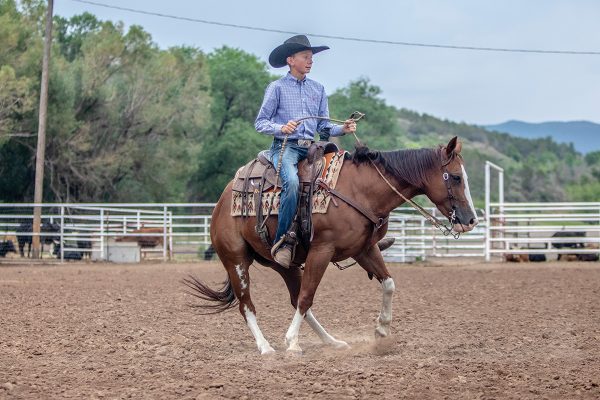
Turn on the Haunches
Aaron says it’s important for a horse to know how to turn slowly on his haunches. The move helps your horse obey your leg cues and ensures that you have control over his shoulders and hips.
You’ll use this move when working to maneuver in tight spaces or when riding a trail or even a dressage pattern. You may also use this move in a western rail class if the judge asks for a change of direction on the rail.
“If you just want a turn on the haunches, focus on your exit point,” Aaron says. “Point your chin toward the spot you want to go and aim your reining hand to that point. When your horse moves his front legs to get in line with your chin and your hand, you’re there. Stop the cue by returning your reining hand toward the saddle horn and stop the turn.”
As you turn, make sure to move your inside leg off of your horse’s side to give him room to move his shoulders. You may need to follow your rein cue with a tap from your outside leg to get your horse slowly moving in the turn on the haunches.
Spinning to Win
Aaron explains that a reining spin is built on the same forward motion as the turn on the haunches, but comes when the rider has asked for speed. For the reining spin, the horse is in an athletic stance, ready to propel himself around and around.
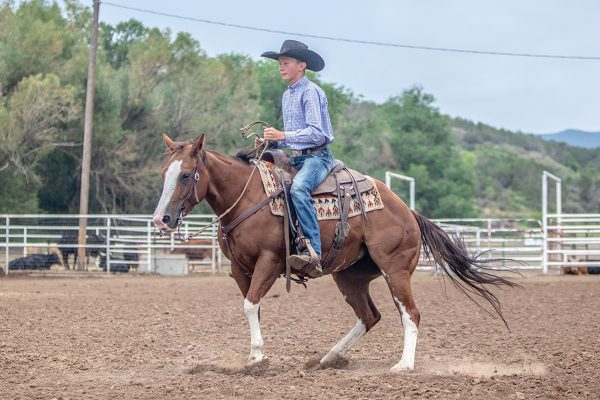
“The horse’s outside front foot is to cross over the inside front foot,” he says. “The inside hind leg is the main pivot foot that bears the most weight. The horse’s outside hind foot helps balance and propel him around. The horse’s inside hind foot remains directly underneath you in the center of the horse. That’s the pivot and balance point. That position allows the horse to turn similarly to how a figure skater spins—with quick, constant movement propelling the spin.”
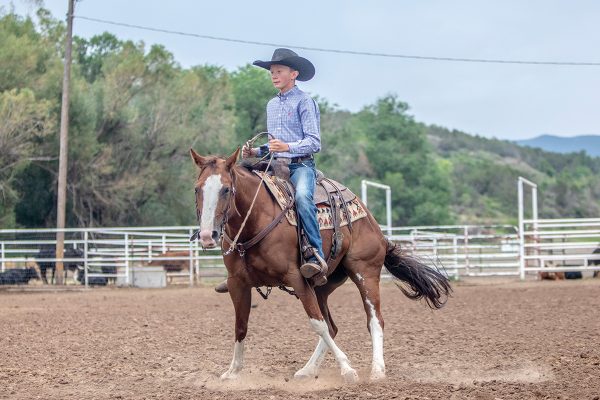
How to Cue for a Reining Spin
Aaron says it’s important to sit in a neutral position with a balanced body—make sure that your shoulder, hip, and heel are vertically stacked.
To rein your horse for the spin, imagine a large clock circling your horse. Your saddle horn is at the 12 o’clock position and your horse’s tail is at 6 o’clock. Begin by picking up your reining hand and pointing to 9 o’clock for a turn to the left, or 3 o’clock for a spin to the right. Point your chin to this same turning position and prepare to add some speed.
“In a reining pattern, you often do four spins in one direction,” Aaron says. “You’re not stopping in a spin until you get to the fourth spin. You want your horse to keep his energy up, not just turn and stop. Only when you’ve done all your rotations do you give your horse a cue to stop. Whether you want to turn a quarter of a turn or a half a turn, your hand guides the way, and your chin marks the spot. When you turn your chin, you’re also giving your horse your body cues to know how far to keep turning.”
To make the spin faster, make sure your horse knows that a sound cue means to add speed.
“If you want speed in the reining spin, cluck to tell your horse to shift gears and keep moving fast,” Aaron says. “If you’re training at home, follow the cluck with a tap of your legs to make sure your horse knows that the sound means to move on. Cluck to get your horse moving one gear faster than you were moving before.”
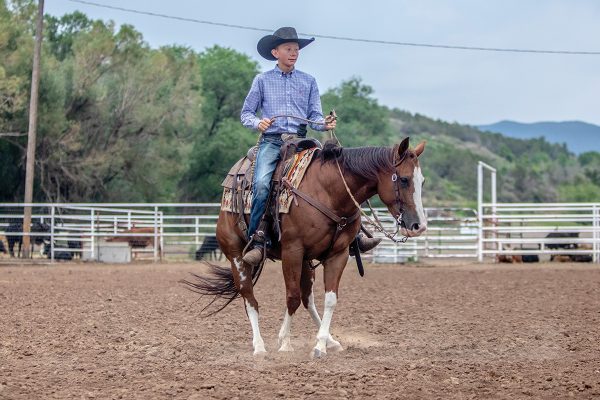
Make sure your horse doesn’t become dependent on your tapping leg cues to stay in a spin. You want him to keep going based on your sound cue. When it’s time to finish your spin, point your chin to the correct stopping place, then when your horse reaches that point, stop your rein aids and return to neutral.
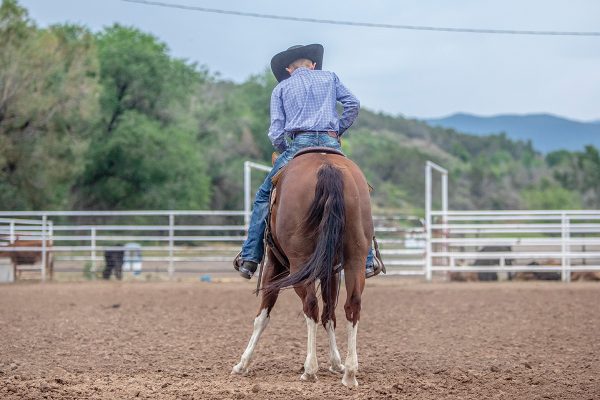
Meet the Trainer
Aaron Ralston works his horses on his family’s Collbran, Colo., cattle ranch and prepares them for world-class competition. He won Top 10 honors at the 2021 AQHA Versatility Ranch Horse World Show in Open Junior Ranch Trail and overall championship finals. He also has championship titles in reining, cutting, working cowhorse, and calf roping, and earned gold for the United States reining team at the FEI World Equestrian Games.
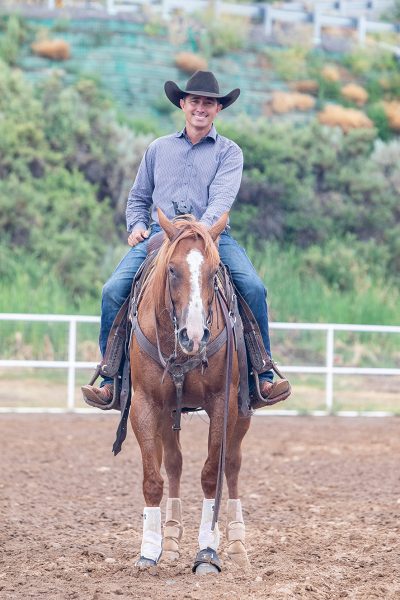
Special thanks to Aaron’s son Parker Ralston for demonstrating these moves aboard Seven S Tuff Boots (aka “Marty”), owned by Meg Ralston.
This article about reining spins appeared in the May/June 2023 issue of Young Rider magazine. Click here to subscribe!

